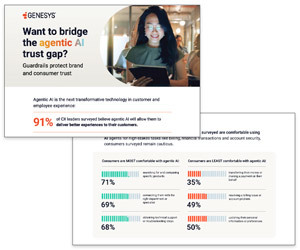Richard Hodges of Genesys discusses the potential pressure on IT when contact centres choose to move to the cloud, before sharing three ways to reduce this burden.
Moving to a modern, cloud-based contact centre has numerous advantages, including flexibility, resilience against outages and reduced reliance on IT.
But the migration process also carries certain risks for call centre agents and managers. And for IT teams, it can be even more challenging. Plan ahead to avoid common pitfalls and preserve your team’s sanity.
1. Know Your Networking Needs
When migrating from an on-premises call centre platform to one built and maintained in the cloud, networking is a key consideration for IT—and can be broken into two primary concerns.
i. For some contact centres, the move to the new platform introduces SIP trunking or VoIP—a massive change from the traditional real-time voice transport technologies.
To ensure a smooth transition for the call centre, IT must make sure both the telecom vendor and internal staff are prepared to operate in a SIP trunking or VoIP environment.
If not, effectively managing the quality of service over networks for real-time communication becomes a constant source of trouble.
ii. Working remotely is gaining popularity in contact centres because it’s flexible, cost-effective and convenient for employees. Unfortunately, that convenience doesn’t transfer to the IT team, as they work to ensure reliable and uniform connectivity for all remote agents.
While there’s no catch-all rule—everything from the number of agents to their geographical locations will affect your individual solution—it’s imperative to develop and implement your solution before transitioning to the new platform.
The ongoing support model is critical for maintaining business-grade service to a constantly changing base of individual users with many different carriers, types of connections and locations.
2. Thoughtfully Design the Desktop and User Interface
Labour cost for agents is the largest component of the contact centre operating budget; agent retention is a key performance metric. So, designing a user interface (UI) that makes agents productive and happy is critical.
Your design process should be a collaboration between the IT systems experts to understand what’s possible, workable and supportable, and the contact centre operations team to determine what they would like to have.
A cloud-based call centre platform provides a true omnichannel environment for customers and agents.
Maximise the benefits of a new system by first identifying what the new UI should be in an omnichannel environment, what platform it should be built on, and what hardware and systems are needed to ensure it all functions reliably.
Design an interface that’s intuitive for your agents and empowers them to expertly and seamlessly address customer issues. An all-in-one system removes the hassle of managing multiple disparate systems, and a robust UI reassures your agents that the change is worthwhile.
Determine where the desktop will live. Weigh the benefits of hosting the agent interface in the new contact centre platform versus in your CRM system. IT managers are uniquely positioned to give insights on managing a new system. Establishing the most beneficial integrations upfront eases the burden of the transition on agents and IT.
Consider variations in hardware and identify what hardware agents need – whether they will have desktop phones or take calls on their computer, whether a single laptop screen will suffice or if multiple screens are needed, etc. This is especially important if your call centre employs remote agents. If machines aren’t uniform across the entire team, your UI must be able to adapt.
As a bonus, this puts you on the right track for the future, as agents become increasingly mobile and as customer desires grow and change. Hot tip: Demand for video is coming; be ready.
3. Plan Ahead to Ensure Reliable Reporting
The most frequently noted issue after the migration is reporting—the lifeblood of a contact centre. As an IT manager, you might not rank it high on your list of concerns during a migration—but you should.
Even if you’re not currently responsible for producing call centre reports, having a plan in place with your call centre manager pre-cutover will save you both a lot of headaches in the long run.
Long before you flip the switch to your new platform, determine what the current reporting needs are, how the new reporting structure will look compared to the old methods, who will be responsible for running reports post-migration and how the call centre manager will get them.
Author: Robyn Coppell
Published On: 27th Mar 2019 - Last modified: 2nd Apr 2019
Read more about - Guest Blogs, Genesys



















